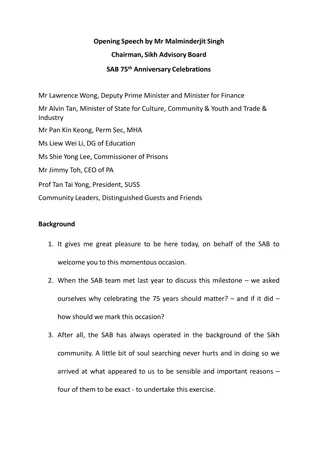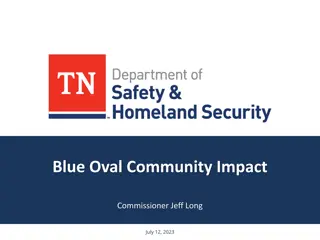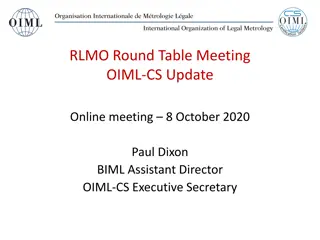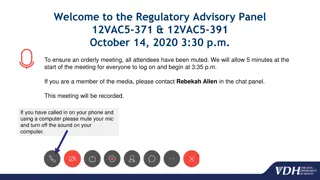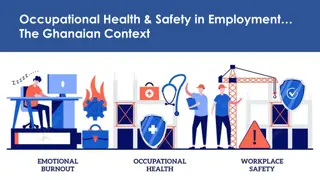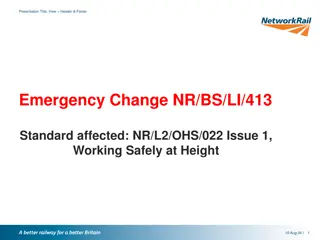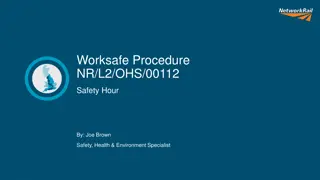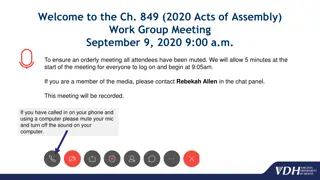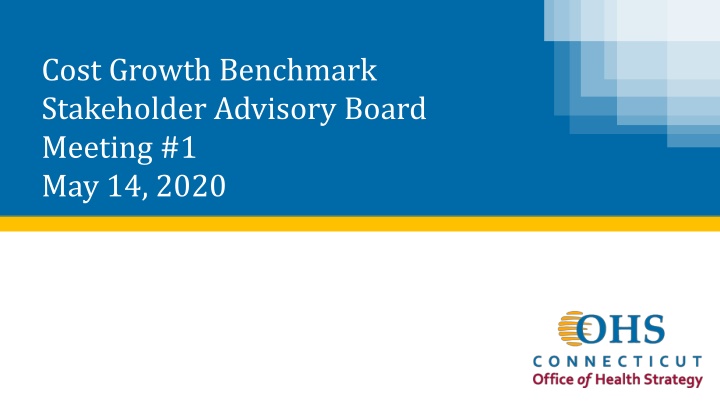
Stakeholder Advisory Board Meeting for Cost Growth Benchmark Stakeholders
Explore the details of the first Stakeholder Advisory Board Meeting discussing the Cost Growth Benchmark on May 14, 2020, including key topics covered and the role of stakeholders in Connecticut's program development.
Download Presentation

Please find below an Image/Link to download the presentation.
The content on the website is provided AS IS for your information and personal use only. It may not be sold, licensed, or shared on other websites without obtaining consent from the author. If you encounter any issues during the download, it is possible that the publisher has removed the file from their server.
You are allowed to download the files provided on this website for personal or commercial use, subject to the condition that they are used lawfully. All files are the property of their respective owners.
The content on the website is provided AS IS for your information and personal use only. It may not be sold, licensed, or shared on other websites without obtaining consent from the author.
E N D
Presentation Transcript
Cost Growth Benchmark Stakeholder Advisory Board Meeting #1 May 14, 2020
Agenda Time 4:00 p.m. 4:05 p.m. 4:15 p.m. 4:25 p.m. 4:55 p.m. Topic Call to Order and Introductions Public Comment Governor Lamont s Charge Charter and Bylaws Role of Stakeholder Advisory Board in the Development of Connecticut s Program Health Care Cost Growth Benchmark: Key Concepts and Context for Connecticut Wrap-up & Next Steps Adjourn 5:05 p.m. 5:25 p.m. 5:30 p.m. 2
Stakeholder Advisory Board Members Vicki Veltri Reginald Eadie Kathleen Silard Janice Henry Robert Kosior Richard Searles Ken Lalime Margaret Flinter Karen Gee Marie Smith Tekisha Everette Pareesa Charmchi Goodwin Howard Forman Nancy Yedlin Fiona Mohring Lori Pasqualini Sal Luciano Kathy Flaherty Hector Glynn Rick Melita Office of Health Strategy (Chair) Trinity Health of New England Stamford Health Anthem Blue Cross and Blue Shield of CT ConnectiCare Merritt Healthcare Solutions Community Health Center Association of Connecticut Community Health Center, Inc. OptumCare Network of Connecticut UConn School of Pharmacy Health Equity Solutions Connecticut Oral Health Initiative Yale University Donaghue Foundation Stanley Black & Decker Ability Beyond Connecticut AFL-CIO Connecticut Legal Rights Project The Village for Families and Children SEIU Connecticut State Council 4
Process for Facilitating Discussion via WebEx We are using the WebEx platform for today s meeting. Please mute your line to reduce background noise. We invite members of the Stakeholder Advisory Board to use the raise your hand feature if you wish to be called upon. Click on the Raise Hand button, which will place a small hand icon next to your name in the participant list. This will alert us that you wish to be called upon. Please unmute your line when you wish to speak. If you have a question or request, please enter it into the Q&A box in the top right-hand panel. Indicate if your request is for everyone, or for the Bailit Health moderator. 5
Process for Facilitating Discussion via WebEx Because the Stakeholder Advisory Board is a large body, it is possible that during the meeting we will not be able to address all of the questions and requests entered into the chat box. Those questions and requests that we cannot get to will receive a response in writing and posted with the meeting summary. 6
Executive Order #5 Directs OHS to: 1. Develop annual health care cost growth benchmarks by December 2020 for CY 2021-2025. 2. Set targets for increased primary care spending as a percentage of total health care spending to reach 10% by 2025. 3. Develop quality benchmarks across all public and private payers beginning in 2022, including clinical quality measures, over/under utilization measures, and patient safety measures. 4. Monitor and report annually on health care spending growth across public and private payers. 5. Monitor accountable care organizations and the adoption of alternative payment models. 9
Connecticut is one of the states that spends the most on health care Personal health care spending, per capita, by state, 2009 and 2014 $10,000 S8,740 $6,892 $8,000 2009 $6,000 $4,000 $2,000 $0 New Idaho Nevada Alabama Iowa Wisconsin West Virginia Virginia Mississippi Montana Kansas Maryland Michigan New Jersey Rhode Island Alaska Arizona California New Mexico Ohio South Dakota Connecticut Texas Oregon Tennessee Illinois Pennsylvania Maine Massachusetts Minnesota Georgia Hawaii US Vermont Utah Colorado Florida Delaware New York North Carolina Indiana Missouri Louisiana Wyoming Arkansas South Carolina Nebraska Oklahoma Kentucky North Dakota Washington $12,000 $9,859 $10,000 $8,045 $8,000 2014 $6,000 $4,000 $2,000 $0 Idaho Alabama Iowa Virginia Kansas Mississippi Wisconsin West Virginia Nevada California Michigan Montana Alaska Texas New Mexico Tennessee Oregon Ohio South Dakota Illinois Maryland New Jersey Rhode Island Connecticut Utah Arizona Pennsylvania Maine Vermont Massachusetts North Carolina Florida Minnesota Georgia Hawaii Louisiana US Missouri Colorado New York Delaware Indiana Wyoming South Carolina Nebraska Arkansas Oklahoma Kentucky North Dakota Washington New Hampshire 10 Source: Centers for Medicare and Medicaid Services, State Health Expenditure Accounts, 2009 and 2014
Yet health care remains unaffordable to many Since 2000, Connecticut employer-sponsored insurance premiums have grown two and half times faster than personal income 250% Worker contributions to premiums (MEPS IC, CT) 200% Family premiums (MEPS IC, CT) 150% 100% Personal income in CT, per capita (BEA) 50% 0% 2000 2005 2010 2015 2020 11 Source: Medical Expenditure Survey, Tables D.1 and D.2 for various years
Connecticut employer-sponsored insurance per capita spending grew 17% in five years ESI Annual Spending Per Person by Service Category Payer & Patient Out of Pocket included Inpatient Outpatient Professional Services Prescription $6,232 $5,941 $5,605 $5,501 $5,329 $1,326 $1,294 $1,203 $1,103 $1,020 $2,203 $2,100 $2,021 $2,020 $2,004 $1,605 $1,517 $1,396 $1,423 $1,368 $1,099 $1,029 $982 $958 $936 2013 2014 2015 2016 2017 12 Source: Health Care Cost Institute 2017 Annual Report Interactive Tables available at https://healthcostinstitute.org/research/hccur/2017- health-care-cost-and-utilization-report
National Healthcare Quality and Disparities Report Overall, Connecticut s quality is in the average range compared to other states and has opportunity for improvement in several key categories of quality measurement. Source: AHRQ. Measurement time period varies by measure. Blue arrows indicate performance most often between 2015-2017 and white arrows indicate performance from 2000-2012. https://nhqrnet.ahrq.gov/inhqrdr/Connecticut/dashboard 13
Connecticuts Cost Growth and Quality Benchmarks, and Primary Care Target Program Role of the Stakeholder Advisory Board 14
Connecticut Benchmarks and Target Program 1 2 3 4 Cost Growth Benchmark The SAB is to advise the Technical Team as it develops recommendations for a cost growth benchmark that covers all payers and all populations for 2021-2025. The SAB is advise the Technical Team to develop recommendations for getting to a 10% primary care target that applies to all payers and populations as a share of total health care expenditures for CY 2021-2025. Primary Care Target This is a complementary strategy that leverages the state s APCD to analyze cost and cost growth drivers. The SAB will provide the Technical Team with input into this strategy. Data Use Strategy Beginning in CY 2022, quality benchmarks are to be applied to all public and private payers. This work will be coordinated through OHS, DSS and the OHS Quality Council, with input from the SAB. Quality Benchmarks
Connecticut Benchmark Program: Key Deliberating Bodies The Connecticut Benchmark Program will be established with the support of key deliberating bodies; the primary body is the Technical Team. The Stakeholder Advisory Board is charged with providing input to the Technical Team on the development of the cost growth target and primary care target. The Quality Council will be charged with developing the Quality Benchmarks with support from OHS and DSS. Other bodies, such as the OHS Consumer Advisory Council, Health Care Cabinet, Practice Transformation Task Force, MAPOC, and other stakeholders will be consulted and will feed into the Stakeholder Advisory Board. 16
Technical Team Members Vicki Veltri Rebecca Andrews Angela Harris Luis P rez Paul Grady Patricia Baker Zack Cooper Melissa McCaw Deidre Gifford Paul Lombardo Rae-Ellen Roy Office of Health Strategy (Chair) American College of Physicians, Connecticut Chapter (Appointed) Phillips Metropolitan CME Church (Appointed) Mental Health Connecticut, Inc. (Appointed) Connecticut Business Group on Health (Appointed) Connecticut Health Foundation (Appointed) Yale University (Appointed) Office of Policy and Management (Designated) Department of Social Services (Designated) Connecticut Insurance Department (Designated) Office of the State Comptroller (Designated) 17
1 The SAB is to advise the Technical Team as it develops recommendations for a cost growth benchmark that covers all payers and all populations for 2021-2025. Cost Growth Benchmark To develop recommendations for a cost growth benchmark the SAB will provide the Technical Team with input on responses to two questions: 1. What health care spending is to be measured? The SAB will weigh in on specific questions related to the measurement of health care spending. 2. How will the cost growth benchmark be set? The SAB will weigh in on the methodology and value of the benchmark. 18
1 The SAB is to advise the Technical Team as it develops recommendations for a cost growth benchmark that covers all payers and all populations for 2021-2025. Cost Growth Benchmark We will review key questions pertaining to the cost growth benchmark with you and will relay your perspective back to the Technical Team prior to it finalizing any recommendation. We will provide you with a synopsis of the preliminary discussions had by the Technical Team to help inform your understanding of the topics and the Technical Team s rationale for preliminary recommendations. 19
2 The SAB is advise the Technical Team to develop recommendations for getting to a 10% primary care target that applies to all payers and populations as a share of total health care expenditures for CY 2021-2025. Primary Care Target The SAB will need to weigh in on two aspects of the primary care target: 1. How is primary care defined and how will spending on primary care be measured? The SAB will weigh in on key questions related to defining what services should be considered primary care. 2. What incremental primary care spend targets should lead up to 10% by 2025, and how should they be determined? The SAB will review preliminary recommendations made by the Technical Team and weigh in on incremental targets. 20
2 The SAB is advise the Technical Team to develop recommendations for getting to a 10% primary care target that applies to all payers and populations as a share of total health care expenditures for CY 2021-2025. Primary Care Target Currently, work to understand Connecticut s primary care spending by payer type is being performed by the New England States Consortium Systems Organization (NESCSO). We will share information on studies to help inform your feedback. 21
3 This is a complementary strategy that leverages the state s APCD to analyze cost and cost growth drivers. The SAB will provide the Technical Team with input into this strategy. Data Use Strategy The Data Use Strategy is a complementary strategy that will be moving forward parallel to the establishment of the Cost Growth Benchmark and Primary Care Targets. Bailit Health s partner, Mathematica, will be developing recommendations and will work with UConn AIMS and OHS on how to utilize the APCD to analyze cost and cost growth drivers so that performance against the cost growth benchmarks, primary care targets and eventual quality benchmarks can be understood. The SAB will review preliminary recommendations for the types of analyses that could be routinely produced, and how those analyses might support insurers, providers, consumers, purchasers and policymakers to take action before the Technical Team finalizes its recommendations. 22
4 Beginning in CY 2022, quality benchmarks are to be applied to all public and private payers. This work will be coordinated through OHS, DSS and the OHS Quality Council. Quality Benchmarks Bailit Health will coordinate with the Quality Council to convey the SAB s input into the development of annual health care quality benchmarks for health care entities and payers that: Report on a standard set; Include measures concerning clinical health outcomes, over- and under-utilization and patient safety, and Consider subpopulations This work will also be coordinated with the work under EO #6 to develop a public transparency strategy for Medicaid cost and quality reporting. The Technical Team will separately provide input on what core measures to include for primary care, specialty care, and hospital performance, and key considerations for setting the benchmarks. 23
Objectives of Stakeholder Advisory Board The Stakeholder Advisory Board will ensure that additional stakeholders from across the healthcare landscape, from consumers to providers, employers and the healthcare industry have input and feedback into the development of: Annual cost growth benchmark across all payers and populations for CYs 2021-2025, including ensuring that the cost growth benchmark does not cause any unintended consequences or exacerbate existing health inequities. Primary care spending targets across all payers and populations as a share of total health care expenditures for CYs 2021-2025 to reach a target of 10% by 2025. A strategy to use the state s APCD to analyze cost and cost growth drivers. Annual quality benchmarks effective for CY22, and analysis of the impact of cost growth benchmarks and primary care targets on quality and equity. 25
Achieving the Objectives The SAB will provide input to inform OHS, the Cost Growth Benchmark Technical Team and the Quality Council. Further, it will: Convene four times between May and September. Provide input relating to the Benchmarks and Targets. Identify unintended consequences of the Cost Growth Benchmark and relay potential solutions to unintended consequences to the Technical Team. Identify existing health inequities that could be exacerbated by the Cost Growth Benchmark and relay potential solutions to unintended consequences to the Technical Team. Provide input to the Technical Team on the State s strategy to utilize the APCD to analyze cost and cost growth drivers. 26
Next Steps for Charter and Bylaws We will incorporate feedback given during today s meeting into a final draft of the Charter and Bylaws. We will share an edited draft prior to the next meeting and then vote upon it when we next meet. 27
Health Care Cost Growth Benchmark Key Concepts and Experience to Date 28
What Is a Cost Growth Benchmark? A health care cost growth benchmark is a per annum rate-of-growth benchmark for health care spending in the state. When implemented, Connecticut will one of five states to have a statewide cost growth benchmark. January to add bullseye slide. 29
What Other States Have a Cost Growth Benchmark? Connecticut s health care cost growth benchmark needs to be designed by and for the people of Connecticut. It is, however, informative to understand how other states have established (or are establishing) cost growth benchmarks. Oregon* Rhode Island Massachusetts 2013 2014 2015 2016 2017 2018 2019 2020 2021 Delaware Connecticut 30 *Due to the COVID-19 pandemic, Oregon may start its program in 2022.
Logic Model for Cost Growth Benchmarks Plans, providers and the State will take action to ensure the target is not exceeded, motivated, in part, by the planned performance transparency and potential Performance Improvement Plans, and supported by improved cost and utilization information from OHS. OHS will annually report on state-level performance against the target, but also on performance at the health insurance market, insurer and large provider levels. OHS will provide better public information on costs and cost drivers through the strategy, using Connecticut s All-Payer Claims Database (APCD) to inform and align policy efforts and stakeholder action. 31
What Does a Cost Growth Benchmark Measure? In the states with benchmarks, the benchmark measures Total Health Care Expenditures (THCE) which is a measure of spending by and for state residents from public and private sources. THCE consists of: Total Medical Expense (TME) spending on all medical services for all state residents regardless of where care was provided, including non-claims- related payments to providers Patient cost sharing (e.g., copay, deductible, co-insurance) Net Cost of Private Health Insurance (NCHPI), a measure of the costs to state residents associated with the administration of private health insurance (including Medicare Advantage plans) 32
What Does a Cost Growth Benchmark Measure? THCE does not include: 1. Non-medical spending made by payers (e.g., gym membership) 2. Vision or dental care not otherwise covered by a medical plan 3. Costs incurred by providers, but not reimbursed by payers (e.g., costs for treating uninsured residents) While this is how the other states have defined THCE, there are many nuances of health care spending measurement that will be discussed by the Technical Team and reviewed by the Stakeholder Advisory Board which may or may not result in a different definition of THCE for CT. 33
How Have Other States Implemented Cost Growth Benchmarks? Massachusetts enacted its cost growth benchmark as part of a legislative package of health care reforms in 2012. Delaware and Rhode Island enacted cost growth benchmarks through executive order in 2018 and 2019, respectively. In Rhode Island, prior to the executive order the major insurers and the largest providers signed a compact in 2018 agreeing to meet the target. Oregon passed legislation calling for a committee of stakeholders to design a cost growth benchmark program and began meeting in late 2019. Washington passed similar legislation in 2020, but has yet to establish its stakeholder committee. 34
Massachusetts Cost Growth Benchmark Experience From 2012 to 2018, annual health care spending growth averaged 3.38%, below the state benchmark. Target established Commercial spending growth in Massachusetts has been below the national rate every year since 2013. 35
Policy Experts Assessment of the Benchmark Program s Impact Payer and provider rate negotiations are now conducted in light of the 3.6% target. State Auditor study With an expected utilization increase of about 2%, payers and providers generally agree on annual price increases of about 1.5%. David Cutler, HPC member The [cost growth benchmark] does mean something It s more than just a symbol, it becomes an operational component of how our health system works. Stuart Altman, HPC Chair 36
Stakeholder Engagement Plan: Objectives 1. Gather input from key stakeholders, beyond Stakeholder Advisory Board members, to inform work of the Technical Team during its initial formative phase: May to September 2020. 2. Analyze stakeholder input to identify potential implementation concerns, challenges and unintended consequences. 3. After the annual cost growth benchmark and primary care targets are established, educate key stakeholders about what they mean and their impact. 4. Gather input from key stakeholders related to the development of quality benchmarks for CY 2022. 39
Stakeholder Engagement: Two Phases Phase I Outreach to engage stakeholders and solicit their input on the health care cost growth benchmark and primary care target during their formative stages from May to September 2020. during this phase, we will also collect input from stakeholders on the State s quality benchmarks development initiative. Phase II Starting in October 2020, focus on communication and education related to the state s cost growth benchmark, primary care target, and quality benchmarks, while also gathering input on quality benchmarks 40
A Broad Range of Stakeholders Phase I and Phase II activities will be aimed at a broad range of stakeholders: Consumers and consumer advocates Health care providers Self-insured and fully-insured employers and employer associations Health plans Organized labor leaders Benefit consultants Legislators 41
Advisory Board Role with Stakeholder Engagement OHS and the Stakeholder Advisory Board will help identify any additional stakeholders whose input is needed, and also the most efficient means of collecting that input. Please send your suggestions for additional stakeholders whose input is needed to Margaret Trinity at mtrinity@bailit-health.com OHS and the Stakeholder Advisory Board will help determine the best means of soliciting input from each stakeholder group. Each Stakeholder Advisory Board meeting will include updates on stakeholder engagement activities. 42
43 Plan of Meetings Meeting # Date May 14 Meeting Goals Orientation to Governor Lamont s charge Review charter and governing bylaws Review role of Stakeholder Advisory Board Review detailed plan of meetings Review key concepts and context Review and adopt revised charter and governing bylaws Discuss the measurement of total health care expenditures and cost growth benchmark methodology, and gather feedback to share with the Technical Team Review cost growth benchmark values Review primary care spending target activity in other states Review data use strategy goals and possible analyses Discuss any unintended consequences of cost growth benchmark Discuss how to ensure cost growth benchmark does not exacerbate existing health inequities Provide input prior to last meeting of Technical Team 1 2 June, Date TBD July, Date TBD August, Date TBD 3 4


